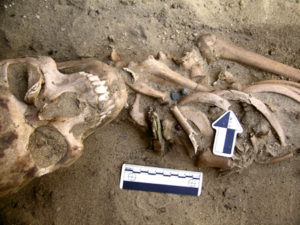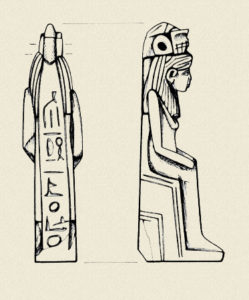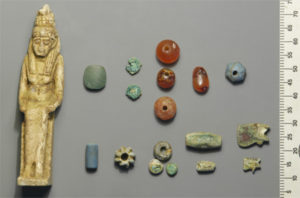By Marie-Astrid Calmettes (Egyptologist), Jessica Kaiser (Osteologist), and Brian V. Hunt

Hatmehyt amulet
More than 2,500 years ago, a very ill young woman died and was buried at the already long-abandoned site of the city of the pyramid builders at Giza. Her grave goods included an amulet of an obscure goddess that suggests the woman may not have been from the Giza area.
Not only that, but she may not have been of Egyptian descent.
AERA’s primary investigation at Giza is the 4th dynasty settlement of the pyramid builders. In one quarter of our dig site, however, we’re faced with the reality that hundreds of Late Period (747-525 BC) burials and a few Old Kingdom (2575-2134 BC) burials cover the site above the 4th dynasty levels. We cannot investigate the older levels without first carefully excavating, recording, and removing the Late Period burials.
At the end of the 4th Dynasty, the pyramid builders abandoned their city to the desert sands. Two millennia later, the ancient Egyptians began burying their dead at the site of the former Giza workmen’s village, by then deeply buried under sand. The first of these burials were interred on a slope along the western edge of our dig site.
A sick girl

Note the Hatmehyt amulet near the woman’s shoulder.
In 2005, osteo-archaeologists Jessica Kaiser and Tom Westlin uncovered 11 burials in this area of the Late Period cemetery. Recovered ceramics suggest the burials date to the 25th Dynasty, earlier than other Late Period burials at our site.
One of the richest interments of this group, burial 407, was that of a young woman of about 16 to 20 years old. Analysis by AERA osteologists showed that she suffered health problems during her short life. Lines in her tooth enamel (enamel hypoplasia) suggest that she was seriously ill during tooth formation in childhood. She survived this illness, but severe pitting in the roofs of her eye sockets (Cribra orbitalia) indicate she probably suffered from iron-deficiency anemia at the time of her death.
Finally, marks on the bones around the ear canals of this young woman (mastoiditis) point to a severe ear infection. This may have been what killed her, since deaths due to ear-infection complications were not uncommon before the introduction of antibiotics.
A non-Egyptian burial?

Drawing of Hatmehyt amulet
Although this is clearly an Egyptian interment with Egyptian burial goods, our craniometrical analysis of the woman implies that she may have been of Central European descent rather than Egyptian. If the amulet suggests the girl had a connection with the Delta city of Mendes (more below), that may be the link with Central Europe, as the Delta had immigrant colonies in the Late Period.
Because of the poor preservation of many of the Late Period skeletons, only a few skulls allowed craniometric analysis. The range of natural variation in the skeletal population is therefore unknown. However, our analysis is based on the vast database in FORDISC 2.0, which also includes both Egyptian (Saite) and Sub-Saharan crania, and burial 407 did not match either of those groups.
Hatmehyt: a sacred connection to Mendes
The woman in burial 407 was interred with a collar made of beads and a faience amulet, about 13 cm high, to protect her in the afterlife. Initially we thought the amulet represented Isis, a very powerful and important mother-goddess of late Egyptian history.
Although the hieroglyphs carved into the amulet are difficult to read and cannot be used to identify the goddess, she wears a headdress topped by a fish. The fish is a key indicator of Hatmehyt, a goddess known as “Foremost of the Fishes.”
Hatmehyt was a local deity, native to Mendes, a town in the eastern Delta. The goddess is often shown seated on a throne with a fish headdress and occasionally crisscrossed with incised lines, perhaps to indicate water. On our amulet, the tail of the fish was long, going down the back of the goddess’ head and then curling back up to create a loop for attaching the amulet to the necklace.
Occasionally Hatmehyt is depicted solely as a fish, like the amulets in the British Museum described by Egyptologist W.M. Flinders Petrie. But her identity is more secure when she takes the form of a woman with a fish headdress, as is the case with our specimen.
Why Hatmehyt?

Amulet with beads from burial necklace
Very little is known about Hatmehyt. She seems to have been a minor goddess, important in Mendes but perhaps not beyond it. Her earliest documented appearance is in the 21st Dynasty, but she may date from earlier periods.
Her epithet “Foremost of the Fishes” is known from the Old Kingdom in the geographical processions with rows of nome deities offering the products of their nome to the gods. But the name “Hatmehyt” is not known before the Ramesside period.
Dr. Richard Redding, our faunal analyst, identified the fish on our amulet as a Schilbe (probably Schilbe mystus, the more northerly of that Nile species), the sacred fish of Mendes.
Hatmehyt may have been selected for inclusion in this burial for a couple of reasons. The Schilbe was said to be in front of other fish; that is, it goes faster and may jump over the water surface. The dead would have to cross the waters of the underworld on their journey to the afterlife and the amulet would offer protection.
In some texts, a fish helped search for parts of Osiris’ body after he was dismembered in the myth of Osiris and Seth. Osiris, of course, was an important deity whom the deceased would meet at the conclusion of her journey through the underworld.
Conclusion
The sacred and profane history of the site of the ancient Giza settlement is richly varied. Although abandoned after the construction of the pyramids, the site apparently retained some sacred association, as the site was not reused until the Late Period Egyptians established their cemetery there. The Late Period burials are teaching us more about the burial practices of that time and adding an important chapter to the history of the site. Once in a while, we are rewarded with something special, like the poignant grave of an ill young woman, protected by a goddess obscure to us but important to her.
